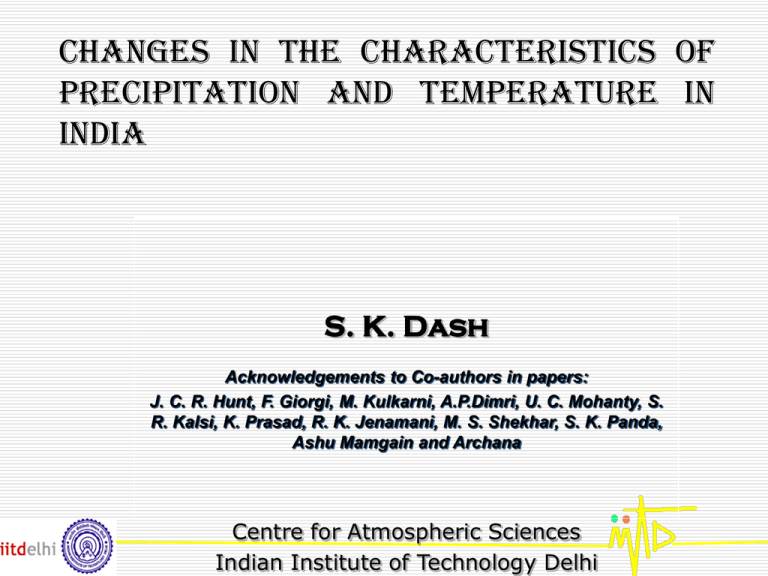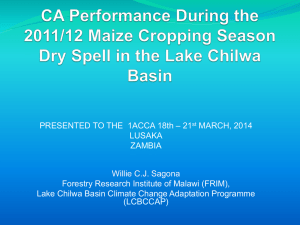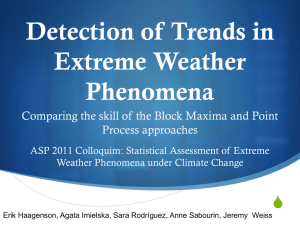- Divecha Centre for Climate Change
advertisement

Changes in the characteristics of precipitation and temperature in india S. K. Dash Acknowledgements to Co-authors in papers: J. C. R. Hunt, F. Giorgi, M. Kulkarni, A.P.Dimri, U. C. Mohanty, S. R. Kalsi, K. Prasad, R. K. Jenamani, M. S. Shekhar, S. K. Panda, Ashu Mamgain and Archana Centre for Atmospheric Sciences Indian Institute of Technology Delhi Outline of the talk Spatial & Temporal Changes in Temperature and Precipitation Agriculture & Health Applications Model Simulations Future Challenges Spatial & Temporal Changes in Temperature and Rainfall Homogeneous rainfall zones of India. The numbers inside the zones indicate mean monsoon rainfall (mm), standard deviation (mm) and coefficient of variation (%) from top to bottom respectively Dash et al., 2002, Mausam, 53(2), 133-144 Western Himalaya + 0.9 0C +0.5 0C Northwest + 0.6 0C - 0.2 0C North Central + 0.8 0C + 0.2 0C Northeast + 1.0 0C +0.2 0C Interior Peninsula + 0.5 0C + 0.5 0C West Coast + 1.2 0C 0 + 0.4 0C East Coast + 0.6 0C + 0.2 0C Changes in the maximum and minimum temperatures in different temperature zones during the last century. The upper numbers indicate maximum and lower ones represent minimum temperatures. Also + sign is for an increase and – is for decrease. The map of seven zones has been obtained from http://www.tropmet.res.in Surface air temperature (0C) changes during different seasons averaged over the whole of India (+ sign indicates an increase and – represents decrease) Months Mean (0C) Maximum (0C) Minimum (0C) Jan & Feb (Winter) +1.0 +1.0 – +1.2 +0.2 – +0.7 March-May (Pre-monsoon) +0.3 +0.6 – +0.8 - 0.1 – +0.2 June-September (Monsoon) +0.4 +0.4 – +0.6 -0.2 – +0.4 OctoberDecember (Post-monsoon) +1.1 +1.1 – +1.3 +0.6 – +0.8 Temperature Indices TX90p, TX95p, TX99p TN90p, TN95p, TN99p TX10p, TX05p, TX01p TN10p, TN05p, TN01p WSDI CSDI Extreme temperature indices used Names Definitions Warm days Count of days where maximum temperature TX > 90th, 95th and 99th percentile respectively Warm nights Count of days where minimum temperature TN > 90th, 95th and 99th percentile respectively Cold days Count of days where maximum temperature TX < 10th, 5th and 1th percentile respectively Cold nights Count of days where minimum temperature TN < 10th, 5th and 1th percentile respectively Warm Spell Count of events where maximum Duration Index temperature TX >90th percentile for at least six days continuously Cold Spell Count of events where minimum Duration Index temperature TN <10th percentile for at least six nights continuously IETCCDI Klein Tank et al. (2009) http://www.clivar.org/organization/etccdi/etccdi.php Dash et al., 2011, J Appl Met & Climat Summary of trends in annual and seasonal means of maximum and minimum temperatures with trends in different categories of warm days and nights in summer Dash et al., 2011, J Appl Met & Climat Summary of trends in annual and seasonal mean of maximum and minimum temperatures with trends in different categories of cold days and nights in winter Dash et al., 2011, J Appl Met & Climat (b) Summer nights (c) Winter days (d) Winter nights Density Density (a) Summer days Temperature (oC) Temperature (oC) Decadal variations in the temperature probability density functions (PDFs) for entire India in the years from 1969 to 2005 during (a) summer days, (b) summer nights, (c) winter days and (d) winter nights. The smoothed curves represent the fit of the GEV distribution. Dash et al., 2011, J Appl Met & Climat Some inferences on surface temperature Indication of warming: Differences in the trends in the minimum and maximum temperatures in the North and south. Different impacts of Ocean and Himalayas to be examined. Asymmetry in the increasing temperature trends between different seasons. In last 2-3 decades the increase in maximum and minimum temperatures during October to February is about 0.30C more than during rest of the months. Significant decrease in the frequency of occurrence of cold nights in the winter months and increasing trend in the number of warm days in summer. 92.0 11-years running means (Monsoon) 1999 1991 1983 78.0 1975 78.0 1967 80.0 1959 80.0 1951 82.0 1943 82.0 1935 84.0 1927 84.0 1919 86.0 1911 86.0 1903 88.0 1895 88.0 1887 90.0 1879 90.0 1871 Rainfall (cm) 92.0 Year Time series of rainfall in India during monsoon months of June, July, August and September. Dash et al., 2007, Climatic Change, DOI 10.1007 Classification of rain events based on intensities Gamma Cumulative Distribution Function was fitted to the daily rainfall values to categorise the rain events in different groups. The classification is made as follows Heavy : Inverse of gamma CDF for probability ≥ 0.99 Moderate : Inverse of gamma CDF for probabilities lie between ≥ 0.4 & <0.99 Low : Inverse of gamma CDF for probability < 0.4 Characteristics of rain events based on duration of spells Long Spell: Consecutive rainfall for ≥ 4 days Short Spell: Consecutive rainfall for less than 4 days Dry Spell: <2.5mm/day Prolonged Dry Spell : consecutively dry for ≥ 4 days 400 Winter Monsoon Pre-Monsoon Winter Monsoon Pre-Monsoon 1600 100 1400 n n n 200 1200 0 1000 1950 1960 1970 1980 1990 0 1950 2000 Years 500 Post-Monsoon 1960 1970 2500 Post-Monsoon 1980 Years 1990 2000 n n 2000 1500 0 1950 1960 1970 1980 1990 2000 1950 1960 1970 1980 1990 Years Number of long spell rain events. Continuous rainfall for ≥4 days over all India Years 1960 1970 1980 1990 2000 2010 Years Annual Annual 1950 2000 The number of long spell rainfall events shows decreasing trend in monsoon season in last 54 years. This suggests that planetary scale motions, may be southwest monsoon over the country is weakening. in different seasons. The red line is linear trend line. Dash et al. 2009 J. Geophys. Res. Vol. 114 1000 Winter Winter Pre-Monsoon Pre-Monsoon 2250 800 2000 1750 n n 600 Annual 1500 400 Annual 10000 1250 9000 200 1950 1960 1970 1980 1990 2000 1950 1970 1980 Years 1990 2000 n Years 1960 3000 5000 Monsoon Post Monsoon Monsoon Post-Monsoon 8000 2500 7000 4500 2000 n n 1950 1960 1970 1980 1990 2000 Years 1500 4000 1000 3500 1950 1960 1970 1980 Years 1990 2000 500 1950 1960 1970 1980 1990 2000 Years Number of short spell rain events (Continuous rainfall for < 4 days) over all India in different seasons. The red line is linear trend line. Short spell rainfall events over India show increasing trend. This is an indication of increasing or intensifying of meso-scale conventions and synoptic scale motions. Dash et al. 2009 J. Geophys. Res. Vol. 114 Summary of trends in heavy and moderate rain events in different Indian regions for the summer monsoon season. Asterisks denote Dash et al. 2009 J. Geophys. Res. Vol.114 significant trend at 5% level. Summary of trends in long, short, dry and prolonged dry spells of rainfall in different Indian regions for the monsoon season. Asterisks denote significant trend at 5% level. Dash et al. 2009 J. Geophys. Res. Vol.114 Some inferences on rain events Heavy rain events increase and moderate & low events decrease Short & dry spells increase and long spells decrease Trends not statistically significant in all zones Weakening of monsoon circulation? Difference between the 850hPa mean monsoonal wind speeds in the two decades (1991-2000) and (1951-1960). The shaded region shows the significant change calculated using t test at 5% level. Dash et al. 2009 J. Geophys. Res. Vol.114 16.0 (a) Depressions 11-year Running Means 14.0 12.0 12.0 10.0 10.0 8.0 8.0 6.0 6.0 4.0 4.0 2.0 2.0 0.0 0.0 1889 1893 1897 1901 1905 1909 1913 1917 1921 1925 1929 1933 1937 1941 1945 1949 1953 1957 1961 1965 1969 1973 1977 1981 1985 1989 1993 1997 2001 Frequency 14.0 16.0 Year 16.0 14.0 (b) Lows 16.0 11-Year Running Means 14.0 12.0 10.0 10.0 8.0 8.0 6.0 6.0 4.0 4.0 2.0 2.0 0.0 0.0 1889 1893 1897 1901 1905 1909 1913 1917 1921 1925 1929 1933 1937 1941 1945 1949 1953 1957 1961 1965 1969 1973 1977 1981 1985 1989 1993 1997 2001 Frequency 12.0 Year Eleven-year running means of annual frequency of disturbances with the minimum intensity of (a) monsoon depressions and (b) low pressure areas over the Indian region (1889-2003) Dash et al., 2004, Current Science,86(10), 1404-1411. 35 30 0 Latitude ( N) 25 20 (a) 15 10 5 0 0 2 4 6 8 10 12 14 16 18 Wind (m/s) 50 (b) 40 550E-950E 30 a)850 hPa 20 0 Latitude ( N) Latitudinal variation of zonal wind component in July over Indian region between 10 b)200 hPa 0 -10 -20 -30 -30 -20 -10 0 10 Wind (m/s) 20 30 40 50 Dash et al., 2004, Current Science,86(10), 1404-1411. Shear(m/s) / Frequency 1.2 0.8 (a) Shear Frequency 0.4 0.0 -0.4 -0.8 -1.2 1953 1957 1961 1965 1969 1973 1977 1981 1985 1989 1993 Year 2.0 Shear(m/s) / Frequency 1.5 (b) Shear Frequency 1.0 0.5 0.0 -0.5 -1.0 -1.5 -2.0 1953 1957 1961 1965 1969 1973 1977 1981 1985 1989 1993 Year (a) 11-year running means of anomalies of horizontal wind shear at 850hPa in August between latitudes 00 and 250 N averaged over longitudes 550E to 950E. (b) 11-year running means of vertical wind shear anomalies in August between 850&200 hPa levels averaged over the 0 Indian region 0 to 250 N and 550E to 950E. Dash et al., 2004, Current Science,86(10), 1404-1411. Further Classification of Rain Events HL: ML: LL: HS: MS: LS: High intensity Long spell Moderate intensity Long spell Low intensity Long spell High intensity Short spell Moderate intensity Short spell Low intensity Short spell Trends in heavy-intensity long spell (HL), heavy-intensity short spell (HS), moderate-intensity long spell (ML), moderate-intensity short spell (MS), low-intensity long spell (LL), and low-intensity short spell (LS) in different regions Dash et al., 2011, Theor Appl Climato, Climate models with affiliated country, their surface resolution, incorporated convection schemes and key references 1. CCSM3 (Community Climate System Model, version 3, USA, NCAR) 2. ECHAM5 (European Centre for Medium Range Weather Forecasts and Max Planck Institute for Meteorology in Hamburg version 5, Germany) 3. GFDL-CM2.1 (Geophysical Fluid Dynamics Laboratory Coupled Model, version 2.1, US Department of commerce, NOAA) Convect ion scheme Key Reference Scenario 1.4x1.4 AS Collins et. al (2006) A2, B1 1.9x1.9 MF Jungclaus et. al (2006) A2, B1 USA 2.5x2.0 RAS GFDLDelworth et. CM2.1 al (2006) AS- Arakawa-Schubert, MF-Mass Flux, RAS- Relaxed ArakawaSchubert A2, B1 S. No. Models Country Horizontal Surface Resolution 1 CCSM3 USA 2 ECHAM5 Germany 3 (b) CCSM3 (c) ECHAM5 (d) GFDL 2.1 Future projected changes in mean JJA wind (m/s) at 850hPa in JJA during 20112040 w. r. t. 1961-1990 under A2 scenario Vertical shear (U200-U850) of zonal wind (m/s) in the box 5o-15oN, 40o-70oE Emissions Scenarios Model Base line A2 B1 ECMWF -30.1 CCSM3 -27.9 -26.1 -26.9 ECHAM5 -31.3 -28.6 -29.4 GFDL2.1 -32.5 -30.9 -31.9 (b) CCSM3 (c) ECHAM5 (d) GFDL 2.1 Future projected changes in mean JJA rainfall (mm/day) during 2011-2040 w. r. t. 1961-1990 under A2 scenario Schematic diagram showing the snow line and height of tropopause in (a) (b) Normal atmosphere and Warmer atmosphere. Dash and Hunt, 2007, Current Science, Vol 93 Seasonal mean anomalies (DJF) associated with maximum, minimum and daily mean temperatures (with trend line) at Gulmarg Seasonal mean anomalies (DJF) associated with precipitation along with excess and deficit values based on ± 0.10 standard deviation at Gulmarg Trends and P values for temperature and precipitation indices __________________________________________________________________________________ A1 A2 A3 34°11′49″N, 34°59′32″N, 35°34′55″N, 77°12′28″E, 3570 m 76°57′14″E, 5215 m 76°47′32″E, 5995 m _________________ ________________ ________________ Temperature Precipitation Indices Trend P(trend) Trend P(trend) Trend P(trend) __________________________________________________________________________________ Warm days 0.0122 0.0384* 0.0182 0.0001* 0.0045 0.0317* Warm nights 0.0084 0.6394 0.0253 0.0006* – 0.01 0.0176* Cold days 0.0065 0.5214 0.0069 0.002* – 0.0045 0.0309* Cold nights 0.0109 0.0017* 0.0084 0.0041* – 0.0028 0.1812 Mean climatological 0.0297 0.1578 – 0.0731 0.0009* – 0.0183 0.2968 Precipitation Heavy precipitation 0.3893 0.2727 – 0.3626 0.0005* – 0.0383 0.3061 Days Maximum number – 0.0102 0.8364 0.7461 0.0006* 0.2641 0.5073 Of consecutive dry days Maximum number 1.2246 0.465 – 5.3202 0.0007* – 0.0351 0.0345* of consecutive wet days __________________________________________________________________________________ Dimri and Dash (2010) Curr. Sc. Applications in Agriculture & Health ERFS Project Agricultural Universities Palampur Pantnagar Jodhpur Anand Jabalpur Akola Bhubanswar Rajendranagar Coimbatore Decadal variations in the numbers of heavy, moderate, and low rain days in agro-met divisions Dash et al., 2011, Theor Appl Climato, Trends in the contributions of heavy, moderate, and low-intensity rainfall categories to total respective rainfall in All India, homogeneous zones, and agro-met divisions Dash et al., 2011, Theor Appl Climato, Contributions of different spells of rain to total summer monsoon rainfall Dash et al., 2011, Theor Appl Climato, Percentage changes in various categories of long and short spells in the decade 1991–2000 compared with the 1951–1960 decade Dash et al., 2011, Theor Appl Climato, Some rainfall facts for Agriculture High intensity Short spells increase and Moderate and Low intensity Long spells decrease. Contribution of Moderate Long spells to total rain decreases and Moderate Short spells increases. Contribution of Heavy categories to total rain increases and that of Moderate decreases. Number of workable days 18.00 16.00 14.00 12.00 10.00 Series1 8.00 Series2 6.00 4.00 2.00 0.00 1960-79 1980s 1990s 2000s Decade Fully workable days out of 30 by decade at Delhi in the month of June. (Series 1 is heavy labour; Series 2 is light factory work) Climate change in cities • Numerous cities in South and Southeast Asia are highly vulnerable to climate change. In India, the expected increase in extreme rainfall events and changes to seasonal monsoon patterns will increase the risk of major floods and the likelihood of drought, with severe consequences for the health and livelihoods of millions of people. Climate change in cities objectives (1) to identify generic climate change parameters in four selected cities in India and (2) to scientifically contribute in the local climate adaptation plans. The four selected cities in India are Howrah, Kochi, Madurai and Visakhapatnam. For each of the above cities its local indicators for climate change adaptation are being developed. Model Simulations Model domain used in RegCM3 simulations o o •Central Lat and Long 20 N, 80 E •99 x 118 points along x-y direction •Domain covers 51o E to 109o E and 3oS to 43oN with 55 km grid distance Percentage difference in JJAS precipitation between RegCM3 and Observations RegCM3-IMD RegCM3-GPCP RegCM3-CRU RegCM3-APHRODITE RegCM3-CMAP Dash et al. 2011. Spatial and temporal variations of Indian summer monsoon: An analysis of June August July September JJAS Correlation Coefficients between RegCM3 and IMD observed ensemble mean monsoon rainfall for the period 1982-2009 spanning 28 years. The contours are obtained with 9 point smoothing to the gridded CC 0.53* RMSE 3.40 JUNE CC 0.67* RMSE 3.90 Rainfall (cm) JULY CC 0.61* RMSE 3.18 AUGUSTT CC 0.15 RMSE 5.44 SEPTEMBER CC 0.50* RMSE 10.02 JJAS Inter-annual variations in precipitation simulated by RegCM3 *Significant at 0.05 level Years 2003 good monsoon RegCM3 IMD Standardized Anomaly 2002 weak monsoon Monsoon active spells (blue circle) and break spells (red circles) in the contrasting monsoon years are shown over central India (15-25oN, 75-85oE), the monsoon core zone. Frequency (a) North West India (70-80oE and 25-30oN) RegCM3 IMD (b) Central India (75-85oE and 15-25oN) IMD RegCM3 (c) Peninsular India (75-85oE and 09-15oN) IMD RegCM3 Rainfall (mm) Frequency distribution of area weighted average daily rainfall from June to September in domain of (a) North West 70-80oE and 25-30oN, (b) Central India 7585oE and 15-25oN and (c) Peninsular India 75-85oE and 09-15oN. The smooth curves are obtained using 5point binomial filter. RegCM3 IMD (b) R99pTOT Frequency (a) R95pTOT Years Years Frequency of occurrence of (a) very wet days and (b) extremely wet days in JJAS per year over the Central India domain (70-86oE and 19-25oN) are shown in bars. The smooth curves are obtained using 5-point binomial filter. Summary of RegCM simulations •RegCM3 has well simulated rainfall over the Central India with small dry bias. •Monsoon breaks in the model are of longer life span that those actually observed. •The model simulates less number of active spells than those observed. •These characteristics of model simulated active and break phases of monsoon contribute to less summer monsoon Future Challenges Coordinated Regional Downscaling Experiment (CORDEX) is a program developed by the Task Force on Regional Climate Downscaling of World Climate Research Programme (WCRP). The framework includes regional climate models (RCMs) and statistical downscaling, with an aim of evaluating the strengths and weaknesses of downscaled climate information. Schematic depiction of the primary uncertainties in regional climate change projection Schematic depiction of the first phase CORDEX experiment set-up 3 11 4 8 12 2 7 6 1 5 9 10 Regional domains planned for the CORDEX experiments (some still under discussion); also indicated are existing projects that make use of the corresponding domain Immediate Goals Validating Regional Climate Models at all the homogeneous regions in India, especially over the Himalayas. Downscaling surface temperature and rainfall to the resolutions of impact assessments. Determining the climate uncertainties in temperature and rainfall for applications in Agriculture and Health.








